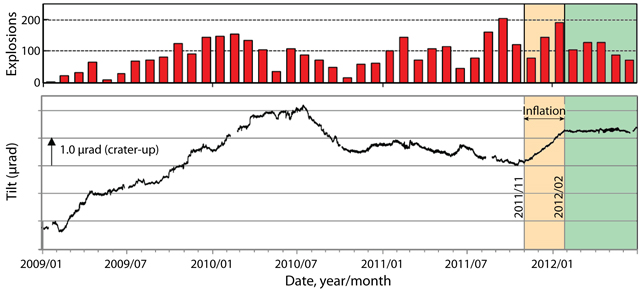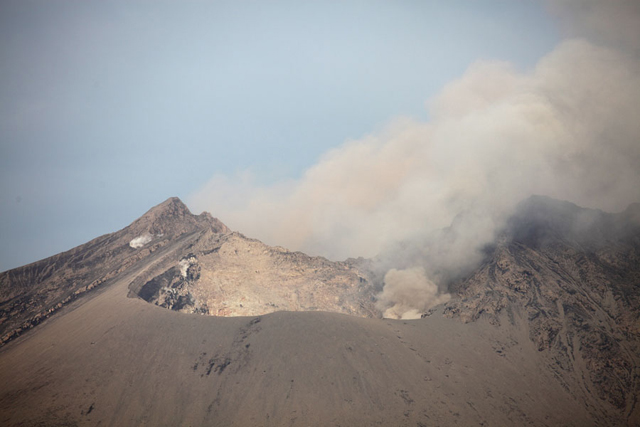Report on Aira (Japan) — May 2012
Bulletin of the Global Volcanism Network, vol. 37, no. 5 (May 2012)
Managing Editor: Richard Wunderman.
Edited by Robert Dennen.
Aira (Japan) Explosions during November 2011-July 2012; ash and health
Please cite this report as:
Global Volcanism Program, 2012. Report on Aira (Japan) (Dennen, R., and Wunderman, R., eds.). Bulletin of the Global Volcanism Network, 37:5. Smithsonian Institution. https://doi.org/10.5479/si.GVP.BGVN201205-282080
Aira
Japan
31.5772°N, 130.6589°E; summit elev. 1117 m
All times are local (unless otherwise noted)
This report provides highlights of activity at Sakura-jima during November 2011-July 2012 (following the previous report in BGVN 36:10). Over this interval, activity was characterized by consistent explosive eruptions that generated many plumes. Inflation of the edifice occurred over the first few months of the reporting period. Information was provided by the Japan Meteorological Agency (JMA) and the Tokyo Volcanic Ash Advisory Center (VAAC), unless otherwise noted. This report concludes with recently published research on the health consequences of exposure to ash erupted from Sakura-jima.
November 2011-July 2012. The reporting interval of the previous Bulletin report ended in a period of deflation of Sakura-jima's edifice (BGVN 36:10, covering through October 2011). Coincidentally, JMA reported that Sakura-jima entered a period of inflation around the beginning of November 2011 (figure 39). That same episode of inflation continued through late January 2012, after which tilt measurements indicated little change through July.
JMA reported that explosive eruptions occurred on average at a rate of more than two explosions per day (figure 39) during November 2011-July 2012. Explosions from Showa Crater commonly ejected tephra and/or ballistics up to 1.3 km from the crater. Plumes were reported to have risen 1-3 km above sea level (a.s.l.) by JMA and Tokyo VAAC more often than weekly; occasional plumes rose to 4 km a.s.l, and on 22 and 24 June, plumes rose 6.1 km a.s.l. Many plumes may have been ash-bearing, but Tokyo VAAC does not report ash content unless citing a pilot report (usually about once a week at Sakura-jima during the reporting interval). Noted exceptions from the common eruptive behavior over this reporting interval are explosions which ejected tephra up to 2 and 1.8 km from Showa Crater on 12 March and during 18-21 May 2012, respectively, and an explosion from Minami-dake Crater on 24 July that ejected ash up to 1.7 km from the crater. Pyroclastic flows traveled 200-300 m down the flanks of Showa Crater on 21 May and between 4 and 8 June.
Richard Roscoe, a visitor to the volcano, photographed Showa Crater in April 2012, and noted that it was ~20% wider in the N-S direction as compared with early 2010 (figure 40).
Health effects of Sakura-jima ash. Hillman and others (2012) characterized ash from Sakura-jima and possible health concerns due to exposure to the ash; they primarily sampled recently erupted ash, but also sampled older units up to ~500 years old (from 1914 and 1471-1476 A.D.) to assess possible health concerns in the event that Sakura-jima returns to previous eruptive styles, including Plinian explosive eruptions. Their analyses aimed to, among others, measure the amount of cristobalite (a silica polymorph known to cause respiratory diseases) in the ash, characterize the grain morphology of ash particles, assess the surface reactivity of the particles, and test the potential of ash particles to cause hemolysis ? the rupturing of red blood cell membranes.
From their work, Hillman and others (2012) reported that all analyzed samples contained low concentrations of cristobalite compared to explosively generated ash at other volcanoes, and other silica polymorphs (quartz and tridymite) were not found. While a greater percentage of respirable ash is often generated during Plinian eruptions, the authors reported the lowest concentrations of cristobalite in ash from Plinian eruptive phases at Sakura-jima.
Morphologically, the authors found many respirable grains adhered to other particles. They also found nano-scale fibers, but reported that they were not related to asbestos in composition or morphology, and were of too low concentration to pose a respiratory hazard.
The surface reactivity of ash particles was reported to be low compared to other volcanoes, and Hillman and others (2012) concluded that "iron related reactivity, as a mechanism for disease, is unlikely at Sakura-jima volcano." They also reported that ash particles had a low-to-mild potential of causing hemolysis. They concluded that ash from Sakura-jima does not have a high potential of causing respiratory disease via the mechanisms studied, but stated that other potential sources of toxicity needed to be analyzed.
Reference. Hillman, S.E., Horwell, C.J., Densmore, A.L., Damby, D.E., Fubini, B., Ishimine, Y., and Tomatis, M. (2012) Sakurajima volcano: a physico-chemical study of the health consequences of long-term exposure to volcanic ash, Bulletin of Volcanology, 74:913-930 (DOI: 10.1007/s00445-012-0575-3).
Geological Summary. The Aira caldera in the northern half of Kagoshima Bay contains the post-caldera Sakurajima volcano, one of Japan's most active. Eruption of the voluminous Ito pyroclastic flow accompanied formation of the 17 x 23 km caldera about 22,000 years ago. The smaller Wakamiko caldera was formed during the early Holocene in the NE corner of the caldera, along with several post-caldera cones. The construction of Sakurajima began about 13,000 years ago on the southern rim and built an island that was joined to the Osumi Peninsula during the major explosive and effusive eruption of 1914. Activity at the Kitadake summit cone ended about 4,850 years ago, after which eruptions took place at Minamidake. Frequent eruptions since the 8th century have deposited ash on the city of Kagoshima, located across Kagoshima Bay only 8 km from the summit. The largest recorded eruption took place during 1471-76.
Information Contacts: Japanese Meteorological Agency (JMA), Otemachi, 1-3-4, Chiyoda-ku Tokyo 100-8122, Japan (URL: http://www.jma.go.jp/); Tokyo Volcanic Ash Advisory Center (VAAC), Tokyo, Japan (URL: http://ds.data.jma.go.jp/svd/vaac/data/); Richard Roscoe, Photo Volcanica (URL: http://www.photovolcanica.com/).



